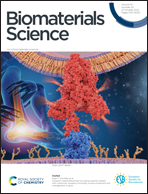Bisphosphonate type-dependent cell viability suppressive effects of carbon nanohorn–calcium phosphate–bisphosphonate nanocomposites†
Abstract
In the process of bone metastasis, tumor cells spread to the bones to activate osteoclasts, which cause pathological bone resorption and destruction. Bisphosphonates (BPs) inhibit osteoclast activation to resorb bone, reducing bone pain and fracture. We previously developed a nanocomposite for potential localized treatment of bone metastasis by loading a BP compound, ibandronate, onto oxidized carbon nanohorns (OxCNHs), a next-generation drug carrier, using calcium phosphates (CaPs) as mediators to generate OxCNH-CaP-BP nanocomposites. The objective of the present study was to determine nanocomposite formation and biological properties of nanocomposites constructed from two BPs, zoledronate and pamidronate. In vitro tests using murine macrophages (RAW264.7 cells) and osteoclasts differentiated from RAW264.7 cells revealed that the resulting OxCNH-CaP-BP nanocomposites suppressed cell viability in a BP type-dependent manner and more effectively than OxCNHs or BPs alone. The mechanism for the potent and BP type-dependent suppression of cell viability by OxCNH-CaP-BP nanocomposites, based on their relative cellular uptake and reactive oxygen species generation, is also discussed. The present study supports the conclusions that BPs can be loaded onto OxCNHs using CaPs as mediators, and that OxCNH-CaP-BP nanocomposites are putative medicines for localized treatment of metastatic bone destruction.



 Please wait while we load your content...
Please wait while we load your content...